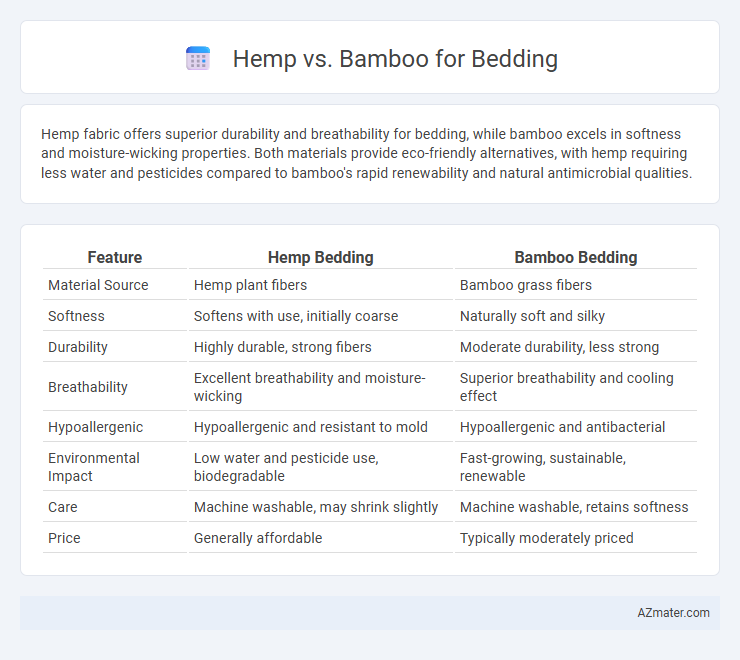Hemp fabric offers superior durability and breathability for bedding, while bamboo excels in softness and moisture-wicking properties. Both materials provide eco-friendly alternatives, with hemp requiring less water and pesticides compared to bamboo's rapid renewability and natural antimicrobial qualities.
Table of Comparison
| Feature | Hemp Bedding | Bamboo Bedding |
|---|---|---|
| Material Source | Hemp plant fibers | Bamboo grass fibers |
| Softness | Softens with use, initially coarse | Naturally soft and silky |
| Durability | Highly durable, strong fibers | Moderate durability, less strong |
| Breathability | Excellent breathability and moisture-wicking | Superior breathability and cooling effect |
| Hypoallergenic | Hypoallergenic and resistant to mold | Hypoallergenic and antibacterial |
| Environmental Impact | Low water and pesticide use, biodegradable | Fast-growing, sustainable, renewable |
| Care | Machine washable, may shrink slightly | Machine washable, retains softness |
| Price | Generally affordable | Typically moderately priced |
Introduction: Hemp vs Bamboo Bedding
Hemp and bamboo bedding both offer sustainable, eco-friendly options prized for their durability and breathability. Hemp fibers are naturally strong and resist bacteria, making hemp bedding long-lasting and hypoallergenic. Bamboo bedding features exceptional softness and moisture-wicking properties, ensuring a cool and comfortable sleep environment.
Material Origins and Sustainability
Hemp bedding originates from the Cannabis sativa plant, known for its rapid growth and minimal pesticide requirements, making it an eco-friendly choice. Bamboo bedding is derived from the bamboo grass, which grows quickly and requires less water than traditional crops, contributing to its sustainability. Both materials offer renewable, biodegradable fibers, but hemp's lower water usage and natural pest resistance give it a slight edge in environmental impact.
Environmental Impact Comparison
Hemp bedding requires significantly less water and pesticides compared to bamboo, making it a more sustainable choice for environmentally conscious consumers. While bamboo grows rapidly and helps reduce soil erosion, its processing often involves chemically intensive methods that can harm ecosystems. In contrast, hemp's natural biodegradability and minimal chemical needs result in a lower carbon footprint and less environmental pollution throughout its lifecycle.
Comfort and Breathability
Hemp bedding offers exceptional breathability and moisture-wicking properties, making it ideal for regulating body temperature and ensuring a cool, comfortable sleep. Bamboo bedding excels in softness and hypoallergenic qualities while maintaining excellent airflow, enhancing overall comfort. Both materials provide sustainable options with hemp being more durable and bamboo offering a silkier feel, catering to different preferences in breathable, comfortable bedding.
Moisture-Wicking and Hypoallergenic Properties
Hemp bedding excels in moisture-wicking due to its breathable fibers that absorb and release moisture quickly, keeping sleepers dry and comfortable. Bamboo fabric is naturally hypoallergenic, resisting dust mites and mold, making it ideal for sensitive skin and allergy sufferers. Both materials offer superior breathability and antimicrobial properties, enhancing sleep hygiene and comfort.
Durability and Longevity
Hemp bedding outperforms bamboo in durability due to its natural resistance to mildew, pests, and wear, ensuring long-lasting use without significant fabric degradation. Bamboo fabrics tend to be softer but may display reduced tensile strength and degrade faster with frequent washes compared to hemp's robust fiber structure. The durability advantage of hemp makes it an ideal choice for eco-friendly bedding designed to maintain integrity and comfort over extended periods.
Care and Maintenance
Hemp bedding is highly durable and becomes softer with each wash, requiring cold water and mild detergent to maintain its strength and texture. Bamboo bedding is naturally moisture-wicking and hypoallergenic, but to preserve its silky feel, it should be washed in cold water on a gentle cycle and air-dried or tumble-dried on low heat. Both fabrics benefit from avoiding bleach and fabric softeners to extend their lifespan and maintain optimal comfort.
Cost and Market Availability
Hemp bedding tends to be more expensive due to its durable fiber processing and smaller-scale production compared to bamboo bedding, which benefits from larger commercial cultivation and faster growth cycles that reduce costs. Bamboo bedding is widely available in many markets, including online and mainstream retail, thanks to efficient farming in Asia, making it more accessible for consumers seeking affordable natural textiles. The higher price of hemp bedding often reflects its superior breathability and sustainability certifications, appealing to niche eco-conscious buyers despite limited mainstream availability.
Eco-Friendliness and Certifications
Hemp bedding stands out for its minimal environmental impact, requiring less water and pesticides than conventional cotton, with certifications like GOTS and OEKO-TEX ensuring sustainable and non-toxic production. Bamboo bedding, often sourced from fast-growing, renewable bamboo plants, is praised for its biodegradable fibers but may involve chemical-intensive processing unless certified by standards such as FSC or OEKO-TEX. Both materials offer eco-friendly options, yet hemp's natural cultivation and lower processing footprint typically provide a stronger certified commitment to environmental sustainability.
Final Verdict: Which Bedding is Better?
Hemp bedding offers superior durability, breathability, and natural moisture-wicking properties, making it ideal for long-term use and allergy sufferers. Bamboo bedding excels in softness, hypoallergenic qualities, and eco-friendliness due to its rapid growth and lower water consumption. Choosing between hemp and bamboo bedding depends on preference for durability and breathability versus softness and sustainability.

Infographic: Hemp vs Bamboo for Bedding
 azmater.com
azmater.com